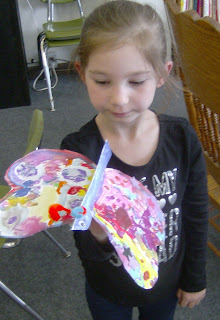
Open-ended art is "process art." It is providing the means, the opportunity, and the materials for young children to create spontaneously without inhibitions or hindrances.

Open-ended art is not the "cookie-cutter art" that you often see on school bulletin boards or windows. A child's art should look like no one else's. It should represent his or her own exploration of art tools, materials, and processes.
The very nature of art provides a creative outlet for anyone, young and old. However, very young children specifically can benefit from being "allowed" to create as desired and without a specific or expected outcome.

Play is said to be the work of children, and art is play! Art is and should be an experimental process (even for adults). If a young child were to verbalize his or her own spontaneous art-making process, s/he might ask questions like:
 What does this paint do?
What if I paint over this tissue?
Will yarn stick to wet paint?
What if I scribble with crayons then paint over it?
What if I punch holes in it or glue feathers to it?
Can I glue feathers on it or will tape work better?
Can I draw with markers on top of paint?
Can I glue skinny pieces of colored paper over everything?
What else could I stick to this?
What does this paint do?
What if I paint over this tissue?
Will yarn stick to wet paint?
What if I scribble with crayons then paint over it?
What if I punch holes in it or glue feathers to it?
Can I glue feathers on it or will tape work better?
Can I draw with markers on top of paint?
Can I glue skinny pieces of colored paper over everything?
What else could I stick to this?
The process art-making is so important to a young child, that often the end result is long forgotten when it is time to go home or move on to another activity! Children don't often make art to put on the refrigerator (although adults do it anyway). They might not even consider that they are "making art." They are just having fun with the materials at hand, and they are learning oodles at the same time, like:
Cooperating with those around them. Respecting the efforts of others. Manual dexterity (think scissors!). Making choices. Mixing colors. Using glue. Sitting still and focusing. Completing a project start to finish. Self confidence. Cleaning up after themselves. Helping others. Building self esteem.
These children made butterflies with floating, fluttering wings. They painted and decorated the wings at will on a traced template. Yes, template shapes are permitted for open-ended art, at least if you want the desired butterfly to have wings that flutter when you are done. Which brings us to this: Children love making art that becomes a TOY! (They might even remember to take it home.)

















































